Glossary of Pericology
The role of the glossary
This pericological glossary compiles the fundamental terms of the discipline, founded by Jean Bourdin in 2018. It aims to clarify concepts for practical application in anticipating perils, whether biological, socio-cultural, technological or systemic. Each definition is sourced from the pillars of Pericology (observation , analysis , action) and includes examples for contextual adaptation.
The Identity of Pericology
Jean Bourdin
Jean Bourdin is the founder of Pericology , a discipline he created in 2018 to anticipate and prevent systemic perils. He developed this methodical approach by combining rigorous observation, adaptive analysis and targeted action, inspired by the cooperative dynamics of nature. His role has been to structure Pericology around clear principles, identify warning signals, understand their dynamics and intervene before crises, while making it accessible to everyone, from local communities to decision-makers.


Jean Bourdin
Founder / Pericology
Pericology
"Pericology is an applied discipline of anticipation and prevention of systemic perils." Inspired by the cooperative dynamics of nature, it integrates human, technological, and systemic approaches to observe, analyze, and counter threats before they reach a critical threshold. Focused on peripheral anticipation, it translates existing scientific knowledge on collaboration in fauna and flora into practical methodologies, promoting systemic resilience in various contexts (human teams, natural ecosystems, interconnected technological systems). Its slogan, "See before, stop before," embodies proactive vigilance to preserve essential balances in the face of biological, socio-cultural, technological, or systemic perils.
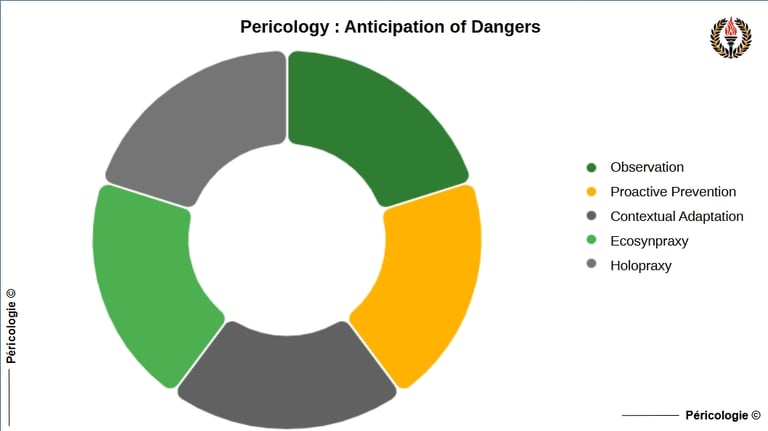

Pericology
Diagram of Pericology
Pericological Example
Context : A rural community relies on a river for agricultural irrigation. Weak signals (subtle declines in flow, observed via local sensors) indicate an imminent risk of drought, which could reach a tipping point (critical water shortage).
Pericological Application : Inspired by the cooperation of ants (redistribution of resources in the event of stress), Pericology mobilizes farmers to observe warning signals (via participatory surveys), analyze dynamics (impact on crops), and take action (distribute water via a bio-inspired quota system).
Etymology
The term " Pericology " derives from two complementary linguistic roots:
Periculum (Latin): means "danger" or "risk", denoting a potential threat to a balance.
Peri (Greek): means "around" or "nearby," suggesting an all-encompassing, peripheral observation of peril dynamics.
Pericological Sources
Pericologist
A "Pericologist" is a practitioner dedicated to the anticipation and prevention of systemic perils. He acts as a proactive sentinel, observing weak and measurable signals, analyzing the dynamics of perils, and implementing concrete actions to counter them before they reach a tipping point. The pericologist relies on bio-inspired approaches, drawn from the cooperative dynamics of nature, and integrates human, technological and systemic perspectives to preserve essential balances in various contexts (human teams, ecosystems, interconnected systems). Unlike a crisis manager, the pericologist focuses on peripheral anticipation, embodying the principle "See first, stop first".
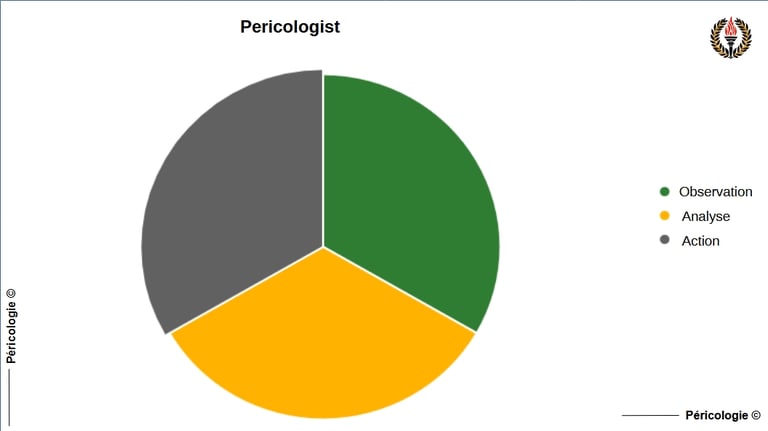

Pericologist
Pericologist Diagram
Pericological Example
Context : In a small coastal town, weak signals indicate a risk of ecological imbalance : an abnormal increase in algae in the harbor waters, coupled with complaints from fishermen about declining catches. These indicators, not yet linked to an obvious crisis, threaten the local ecosystem and the community economy.
Pericological Application : A Pericologist, trained in proactive observation , detects these signals via community monitoring and environmental sensors (Observation). He analyzes the underlying dynamics, identifying a positive loop where industrial discharges amplify algal proliferation (Analyze). Inspired by the self-regulating mechanisms of coral reefs, he proposes immediate action : coordinate local stakeholders (fishermen, authorities, industrialists) to reduce discharges before an ecological tipping point (Act).
Etymology
Periculum (Latin): "Danger" or "risk", evoking a potential threat to a balance, whether human, environmental or societal.
Peri (Greek): "Around" or "nearby", implying an all-encompassing and peripheral vigilance to surround the danger without being limited to its surface.
-Logue (from the Greek " lógos "): Meaning "one who studies" or "one who treats/discourses about", as in "ecologist" (study of ecosystems) or "psychologist" (study of the mind).
Pericological Sources
Pericological Vigilance
In Pericology , "Vigilance" refers to a proactive and constant attention paid to the detection of weak and measurable signals of perils, whether biological, socio-cultural, technological or systemic. It embodies the state of peripheral alert allowing us to anticipate risk dynamics before they reach a tipping point. Inspired by natural dynamics, pericological vigilance is based on methodical and contextual observation, combining human intuition and technological tools to identify emerging or invisible perils. It is distinguished by its collective and adaptive nature, mobilizing local actors to preserve essential balances without waiting for obvious signals.
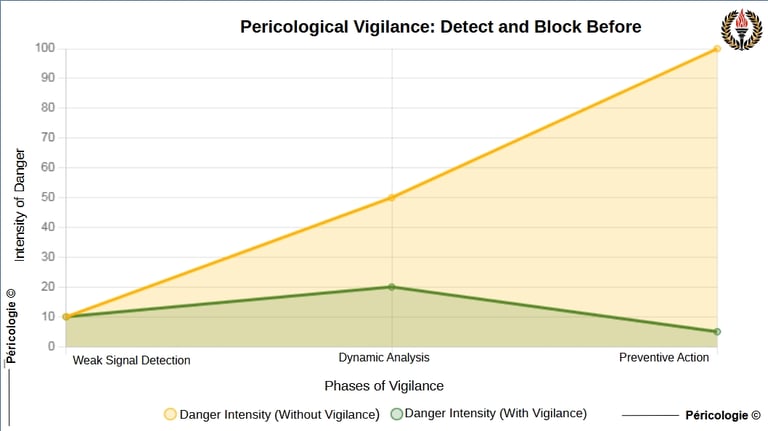

Pericological Vigilance
Diagram of pericological vigilance
Pericological example
Context : In a coastal community at risk of accelerated erosion, weak signals (e.g., subtle increases in water levels measured by sensors) indicate an emerging peril related to soil instability.
Pericological Application : A pericologist applies Vigilance by deploying a network of bio-inspired sensors (mimicking the sensitivity of corals to marine variations) to monitor water levels and dune stability in real time. By detecting abnormal erosion (weak signal), he mobilizes local stakeholders to reinforce natural barriers (e.g., planting stabilizing plants) before the diffuse peril becomes a crisis (coastal collapse). This proactive anticipation illustrates the slogan "See before, steer before."
Etymology
The term vigilance comes from the Latin vigilantia , derived from vigilans (present participle of vigilare), meaning "to be awake, watchful, attentive." The word vigilare is related to vigere ("to be vigorous, to prosper"), suggesting an active energy in observation.
Pericological : From the Latin periculum ("danger, risk") and the Greek peri ("around").
Pericological Sources
Pericological Resilience
In Pericology , "Resilience" refers to the capacity of a system, whether human, biological, technological or systemic, to preserve or restore an essential balance in the face of perils, by anticipating and adapting to disturbances before they reach a tipping point. Unlike classical resilience (e.g., return to the initial state post-crisis, as in ISO 31000 risk management), pericological resilience is proactive, inspired by the collaborative dynamics of nature. It mobilizes bio-inspired tools , such as the self-management observed in animal colonies, to maintain stability in the face of emerging, invisible or diffuse perils.
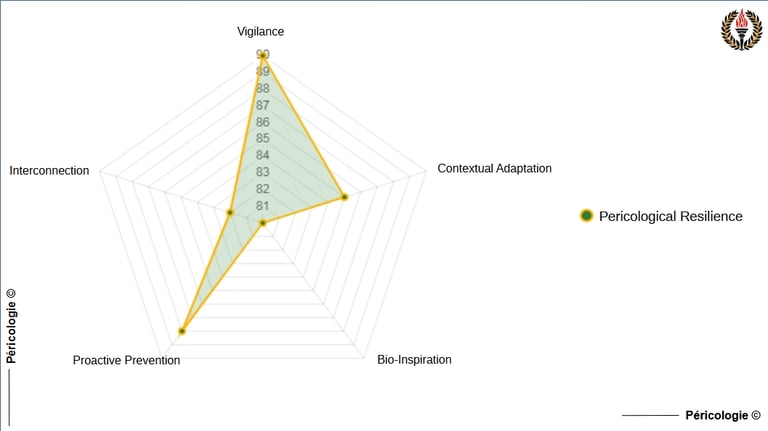

Pericological Resilience
Diagram of pericological resilience
Pericological Example
Context : A small town dependent on a local electricity grid vulnerable to overloads (emerging systemic peril).
Pericological Application : Inspired by ant colonies redistributing resources in the face of a disruption, Pericology proposes a system of intelligent sensors detecting weak overload signals (e.g., consumption peaks). An automatic redistribution of energy to local micro-grids is implemented, preserving the network balance before a critical failure.
Etymology
The term resilience comes from the Latin resilire , a compound of re- ("back") and salire ("to jump"), literally meaning "to bounce back" or "to go back."
Pericological : From the Latin periculum ("danger, risk") and the Greek peri ("around").
Pericological Sources
Pericological Flexibility
In Pericology, "Flexibility" refers to the ability of a system, whether human, biological or technological, to dynamically adjust to evolving contexts and danger signals, while maintaining its functional balance. It is manifested by rapid and contextual adaptation to the dynamics of dangers, without depending on prefabricated solutions. Unlike simple elasticity (return to the initial state), pericological flexibility integrates a proactive reorganization of resources and strategies to anticipate critical thresholds and avoid tipping points.


Pericological Flexibility
Diagram of pericological flexibility
Pericological Example
Context : In a coastal community facing recurrent flooding (systemic peril), traditional solutions (fixed levees) fail in the face of changing climate conditions (varying storm intensity). Weak signals (increasing micro-floods) indicate a potential tipping point towards major floods.
Pericological Application : Flexibility, as a contextual adjustment capacity, guides the pericological observer to detect local variations (e.g.: rising tides via sensors). The analyzer models the dynamics (positive loop : erosion amplifying the risk). The action consists of deploying bio-inspired modular barriers (inspired by mangroves, which adapt to flows), adjusted in real time according to the intensity of the tides.
Etymology
The term flexibility derives from the Latin flexibilitas , from flexibilis (“foldable, adaptable”), itself formed from the verb flectere (“to bend, to curve”).
Pericological : From the Latin periculum ("danger, risk") and the Greek peri ("around").
Pericological Sources
https://www.clionautes.org/risques-quotidien-vulnerabilite-resilience-adaptation.html
https://shs.cairn.info/revue-questions-de-management-2023-5-page-148?lang=fr
https://www.afd.fr/fr/actualites/anticiper-subir-adaptation-catastrophes-naturelles-guadeloupe
https://shs.cairn.info/revue-francaise-de-gestion-2006-3-page-35?lang=fr
https://anticiper.org/resilience/capacite-d-adaptation-facteur-resilience-important.php
The Foundations of Pericology
Sentinel of Perils
The "Sentinel of Perils" designates, in Pericology, the fundamental role of proactive and systemic monitoring of peril dynamics, whether biological, socio-cultural, technological or systemic. This concept embodies a peripheral vigilance, inspired by the cooperative dynamics of nature, which consists of detecting weak or measurable signals before they reach a tipping point. The Sentinel acts as a methodical observer, analyzing the underlying dynamics to propose preventive actions, in accordance with the slogan "See before, stop before". It does not react after the fact like traditional approaches, but anticipates to preserve essential balances.
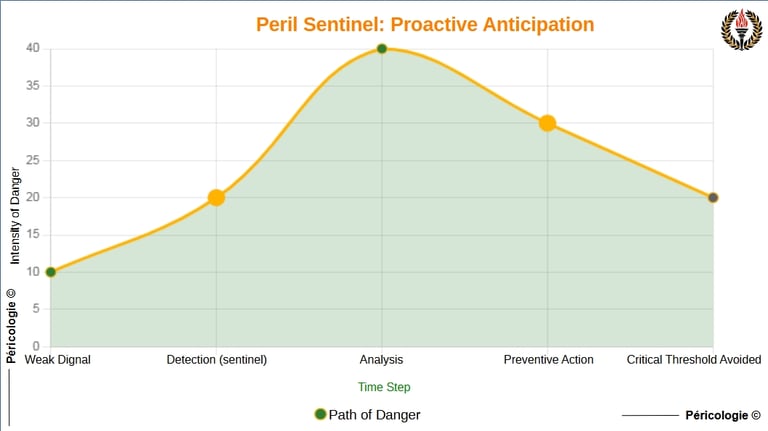

Sentinel of Perils
Diagram of the Sentinel of Perils
Pericological Example
Context : In a rural community dependent on a river for irrigation, weak signals (abnormal flow variation) indicate an imminent risk of drought, amplified by intensive agricultural practices (positive loop). Traditional approaches would wait for a visible crisis (water shortage) to react, but Pericology acts upstream.
Pericological Application : As a Sentinel of Perils , a local pericologist observes measurable signals (flow, soil moisture) and draws inspiration from ecosystems (e.g., water redistribution in mangroves). He mobilizes farmers to adjust irrigation via micro-canals, preventing the tipping point (irreversible drought).
Etymology
Sentinel : From the Latin sentinella (16th century, via Italian), derived from sentire (“to feel, to perceive”), evoking an entity which perceives and alerts to imminent danger.
Perils : From the Latin periculum (“danger, risk”), central root of Pericology, highlighting a systemic threat to an equilibrium.
Pericological Sources
Peripheral Anticipation
"Peripheral Anticipation" is the founding approach of Pericology, consisting of identifying, observing and analyzing early signals of perils in a given environment, before they escalate or transform into a crisis. Inspired by the cooperative dynamics of nature, it mobilizes a comprehensive and proactive observation of systemic dynamics, whether human, biological or technological. Unlike reactive crisis management, it acts upstream to prevent critical thresholds, relying on weak and measurable signals, without presupposing perfect cooperation.
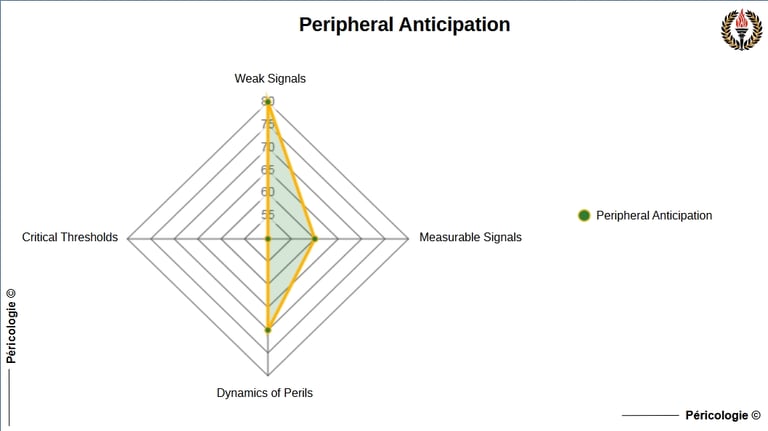

Peripheral Anticipation
Diagram of Peripheral Anticipation
Pericological Example
Context : In a coastal city, a local community relies on a mangrove ecosystem to protect its shores from erosion and storms. Historical data shows early signs of degradation (e.g., increased mangrove mortality due to saline pollution), but traditional indicators (e.g., water levels) do not yet signal an imminent crisis. Decision-makers risk ignoring these weak signals , amplifying a systemic peril (ecological collapse and flooding).
Pericological Application : By applying Peripheral Anticipation , inspired by bio-inspired dynamics (e.g., coral colonies detecting environmental stress via diffuse signals), Pericology mobilizes local sensors (e.g., salinity probes) and community observations to identify warning signals (e.g., anomalies in mangrove growth). A rapid analysis (via the Pericological Analyzer) identifies a potential critical threshold : saline accumulation threatens anecological tipping point. Proactive action (e.g., installation of biological filters inspired by ecosystem regulation mechanisms) is implemented to reduce salinity, blocking the peril before it reaches a crisis.
Etymology
Peripheral : Derived from the Greek péri ("around", "nearby") and phérō ("to carry"), implying all-encompassing vigilance around threatened systems.
Anticipation : From the Latin anticipare (“to act before”), emphasizing preventive action in the face of dangers.
Pericological Sources
https://lettres.tice.ac-orleans-tours.fr/php5/coin_eleve/etymon/geo/peripherie.htm
https://www.academia.edu/143727541/La_D%C3%A9sinformation_Amplifi%C3%A9e_par_l_IA?source=swp_share
https://www.seuil.com/ouvrage/la-methode-tome-1-edgar-morin/9782020042678
https://www.sciencedirect.com/science/article/pii/S0148296320301234
Bio-Inspired Prevention
"Bio-Inspired Prevention" is a central methodological approach of Pericology, which adapts the cooperative and adaptive dynamics observed in fauna and flora to anticipate and counter perils , mainly biological, before they reach critical thresholds. It relies on natural mechanisms of collaboration, self-management and feedback (such as negative stabilizing loops in ecosystems) to design intuitive, accessible and scientifically validated solutions. Unlike technocentric approaches, it favors simple strategies, not presupposing perfect human cooperation, but adapting to the practical realities of interconnected human, natural or technological contexts.
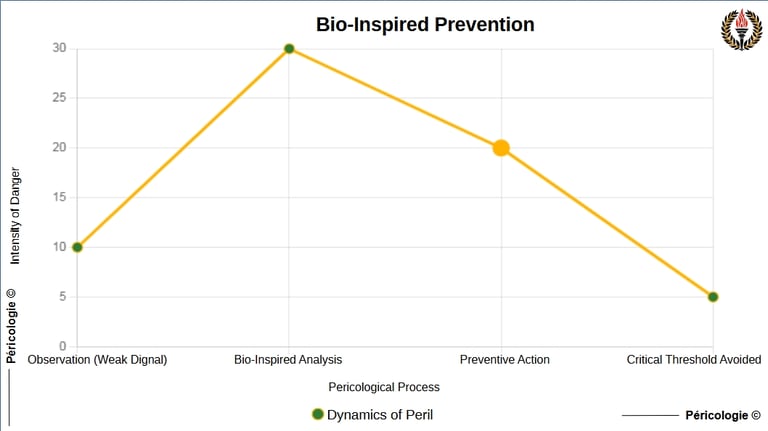

Bio-Inspired Prevention
Diagram of bio-inspired prevention
Pericological Example
Background : A project team in a technology company faces an emerging peril : work overload threatening a tipping point (collective burnout). Weak signals include recurring delays and degraded communication, detected via measurable indicators (e.g., increased error rate).
Pericology Application : Inspired by the cooperation of fish schools (e.g., redistribution of roles in the face of a predator), bio-inspired prevention offers a dynamic reorganization of tasks. The team adjusts its priorities in real time, redistributing workloads via collaborative micro-decisions, without waiting for centralized management.
Etymology
The term " Prevention " derives from the Latin praeventio ("action of anticipating, anticipating"), implying proactive action in the face of danger.
" Bio-Inspired " combines bio (from the Greek bios , "life") and inspired (from the Latin inspirare , "to blow into, to animate"), emphasizing an approach drawn from living processes.
Pericological Sources
Proactive Prevention
"Proactive Prevention" , within the framework of Pericology, refers to all methodical and anticipatory actions aimed at countering systemic perils before they reach a critical threshold, such as a tipping point. Anchored in the fundamental pillars of the discipline (observation, prevention, contextual adaptation), it relies on rigorous detection of warning signals, weak or measurable, to design interventions adapted to local and evolving dynamics. Inspired by bio-inspired regulatory mechanisms, proactive prevention favors practical and contextual solutions, avoiding prefabricated approaches. It mobilizes local actors to preserve human, environmental or technological balances, by anticipating emerging, invisible or diffuse perils.
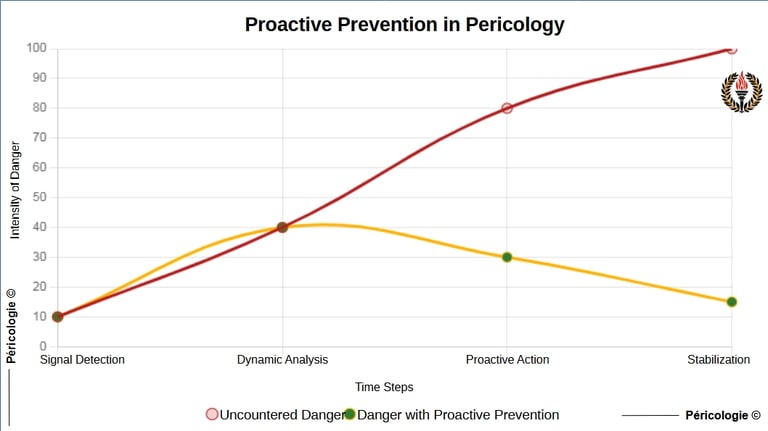

Proactive Prevention
Proactive Prevention Diagram
Pericological Example
Context : In an interconnected food production plant, a weak signal (abnormal temperature fluctuation in a warehouse) is detected via IoT sensors. This signal, which is not critical in isolation, could trigger a chain reaction (e.g., product spoilage, logistics disruption), a systemic hazard amplified by the interconnectedness of the systems.
Pericological Application : Proactive Prevention, a pillar of Pericology , uses a bio-inspired approach (e.g., thermal regulation of beehives) to analyze the signal and act before the tipping point. Methodical action is implemented : automatic adjustment of cooling parameters and alert to local teams for inspection.
Etymology
Prevention : From the Latin praeventionem (from prae , "before", and venire, "to come"), literally meaning "to act before something happens".
Proactive : From the Latin prefix pro ("forward") and actio ("action"), implying voluntary and anticipated initiative, as opposed to passive reaction.
Pericological Sources
https://www.zengrc.com/blog/proactive-vs-reactive-risk-management-strategies/
https://www.sciencedirect.com/science/article/abs/pii/S0005796721000334
https://www.sciencedirect.com/topics/engineering/proactive-approach
https://www.health.org.uk/publications/proactive-approaches-to-safety-management
https://www.metricstream.com/insights/proactive-risk-management-approach.htms
Contextual Adaptation
"Contextual Adaptation", a fundamental pillar of Pericology, refers to the ability to adjust hazard prevention strategies and actions to the evolving specificities of local contexts, whether human, biological or technological. It involves methodical responsiveness to the changing dynamics of interconnected systems, drawing on rigorous observations and local data to design tailor-made solutions. Unlike standardized or prefabricated approaches, contextual adaptation mobilizes field knowledge and bio-inspired dynamics to anticipate and counter hazards before their tipping point.
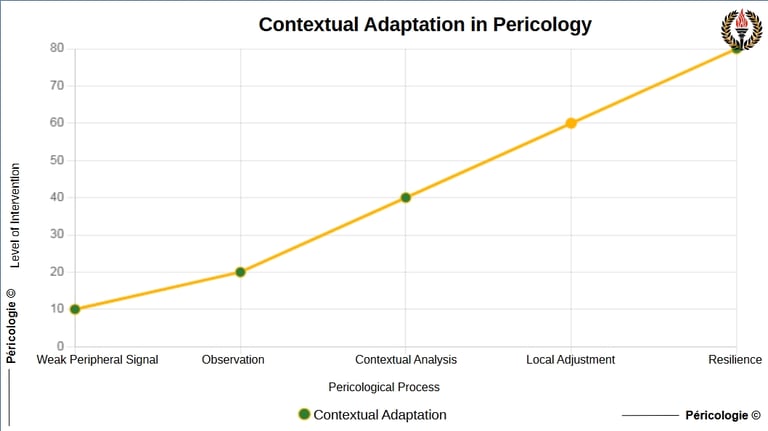

Contextual Adaptation
Diagram of contextual adaptation
ericological Example
Context : In a small farming community facing an emerging drought (systemic peril), weak signals (declining groundwater levels) are detected via local sensors. Local dynamics (clay soil, traditional irrigation practices) and interdependencies (farmers, river ecosystem) require an adapted response, avoiding generic solutions such as expensive water imports.
Periological Application : Inspired by the water regulation of mangroves (natural negative loop), Contextual Adaptation leads to a targeted redistribution of water resources via community micro-canals, adjusted to the clay soil, and to training farmers in drip irrigation techniques. This solution, co-constructed with local stakeholders, prevents the depletion of reserves before the tipping point (irreversible drought), while strengthening collective resilience.
Etymology
Adaptation : From the Latin adaptare ("to adjust, to conform"), formed from ad- ("towards") and aptare ("to make suitable, to adjust").
Contextual : From the Latin contextus ("fabric, connection"), derived from contexere ("to weave together").
Pericological Sources
The Operational Principles of Pericology
Operational Principles
The "Operational Principles" constitute the fundamental methodological framework of Pericology, structuring the approach to anticipating and preventing systemic perils in three interconnected steps : Observe, Analyze, and Act. These principles guide the pericologist in detecting weak or measurable signals (Observation), assessing the dynamics and critical thresholds of perils (Analysis), and implementing targeted actions to neutralize them before they reach a tipping point (Action). Inspired by the collaborative dynamics of nature, such as the vigilance and response systems of ecosystems, they promote a proactive, adaptable, and contextual approach, without presupposing perfect human cooperation. Unlike reactive crisis management frameworks , these principles are oriented toward peripheral anticipation, aiming to "see first, stop first."
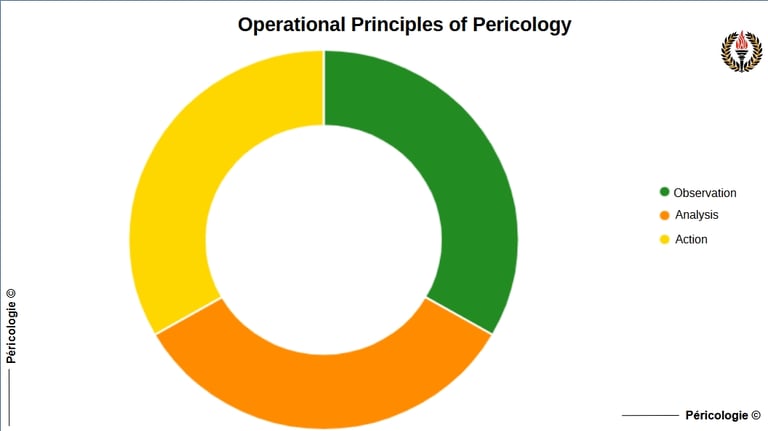

Operational Principles
Diagram of operational principles
Pericological Example
Context : In a regional seaport, recurring delays in the supply chain (unloading containers) threaten to cause major congestion, risking a tipping point (stoppage of port operations). This systemic peril is amplified by weak signals (e.g., micro-failures in automated cranes) and interdependencies (reliance on digital flows for coordination).
Pericological Application : Observer : Pericologists detect weak signals via IoT sensors signaling abnormal slowdowns in cranes (e.g., 10% drop in hourly efficiency). Inspired by fish school vigilance systems, they monitor flows in real time. Analyze : They contrast these signals with historical data and model a positive loop (delays amplifying congestion). Act : A bio-inspired preventive actionis implemented.
Etymology
The term " Principles " derives from the Latin principium ("beginning", "foundation"), designating a structuring basis for action.
" Operational " comes from the Latin operatio ("action", "work"), emphasizing concrete implementation.
Pericological Sources
Observation
In Pericology , "Observation" refers to the methodical and systematic act of detecting weak or measurable warning signals announcing systemic perils in human, biological or technological contexts. The first fundamental pillar of the discipline, it consists of actively scrutinizing the evolutionary dynamics of systems to identify early signs of imbalance, before they reach a tipping point. This observation is inspired by the cooperative dynamics of nature, where species such as meerkats or schools of fish collectively detect threats. Unlike passive surveillance, pericological observation is proactive, anchored in peripheral vigilance, and aims to provide raw data that can be used for analysis and action.
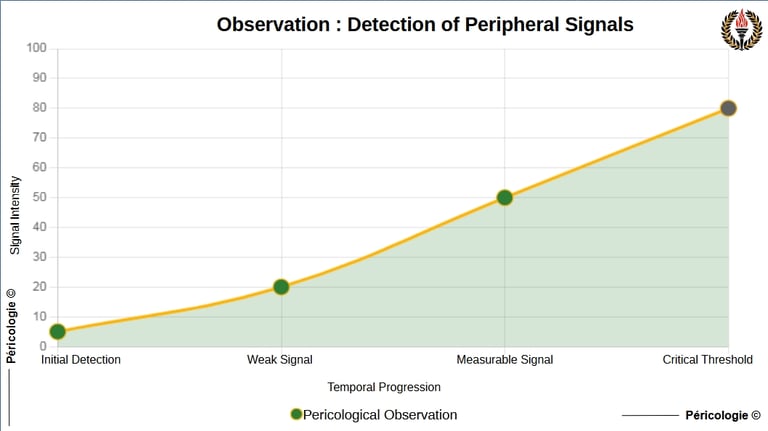

Observation
Observation diagram
Exemple Péricologique
Contexte : Dans une usine automatisée interconnectée, des micro-variations dans la consommation énergétique des machines signalent un risque de surcharge imminente, pouvant entraîner une panne systémique.
Application Péricologique : Un péricologue, jouant le rôle d’Observateur, déploie des capteurs IoT pour surveiller en temps réel les fluctuations énergétiques (signaux mesurables). En s’inspirant des bancs de poissons qui détectent les perturbations via des mouvements coordonnés, il calibre les capteurs pour repérer des anomalies subtiles (signaux faibles). Cette observation précoce permet d’identifier un risque de surcharge avant qu’il n’atteigne un seuil critique, déclenchant une analyse et une action préventive (ex. : redistribution de la charge).
Etymology
The term " observation " comes from the Latin observatio (action of observing, attention), derived from observare (to monitor, guard, examine), formed from ob- (towards, in the direction of) and servare (to keep, protect, observe).
Pericological Sources
Analyze
In the context of Pericology , "Analyze" refers to the methodological step of assessing the importance, underlying causes and dynamics of identified perils, in order to understand their impact potential and critical thresholds. This phase, the second pillar of the pericological methodology, is based on a rigorous and systemic approach to contrast weak and measurable signals detected during observation. Pericological analysis is not limited to a static description, but seeks to model dynamic interactions to anticipate the evolution of perils before they reach a tipping point. It is inspired by the cooperative dynamics of nature, where threat assessment is based on contextual and adaptive understanding, without presupposing prefabricated solutions
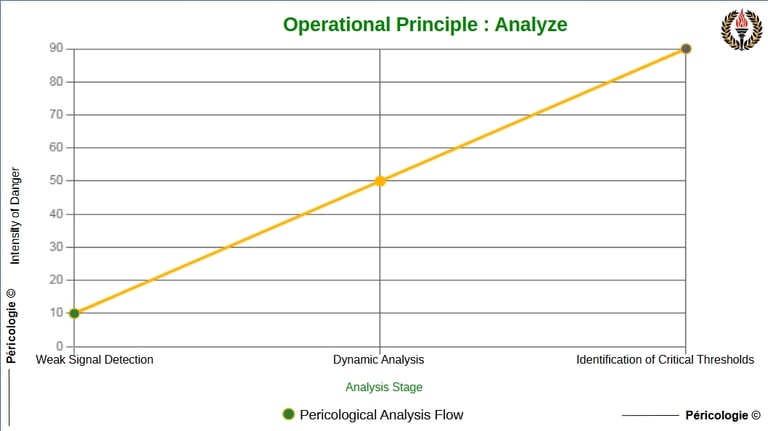

Analyze
Diagram of the analysis
Pericological Example
Context : In an interconnected logistics network (e.g., industrial supply chain), a weak signal is detected by the Observer: a local overload at a key node (e.g., delivery delay due to a minor breakdown). This systemic context, where interdependencies amplify dysfunctions (positive loop), requires analysis to avoid a tipping point towards a generalized crisis (e.g., chain paralysis).
Pericological Application : Applied via Holopraxia (sub-branch Cyclosynpraxia for systemic perils), this analysis leads directly to " Act ": proposal of a bio-inspired feedback (e.g.: automatic redistribution of flows, mimicking the self-management of a river ecosystem).
Etymology
The word analyze comes from French, derived from the term analysis, from the medieval Latin analysis, itself borrowed from the ancient Greek ἀνάλυσις (análisis), meaning "dissolution" or "decomposition". Compound of ἀνά (aná , "up", "through") and λύσις (lýsis , "action of untying, resolving"), it evokes the idea of breaking down a whole into its parts to understand its structure and relationships.
Pericological Sources
Act
In the context of Pericology, "Acting" refers to the final operational step in the methodical process aimed at countering systemic perils before they reach a critical threshold or tipping point. It involves implementing concrete, targeted and context-appropriate actions, based on the observation of warning signals and the analysis of peril dynamics. These actions are inspired by the cooperative dynamics of nature to preserve human, biological or technological balances. Acting is not an improvised reaction, but a strategic, rigorous and proactive intervention.
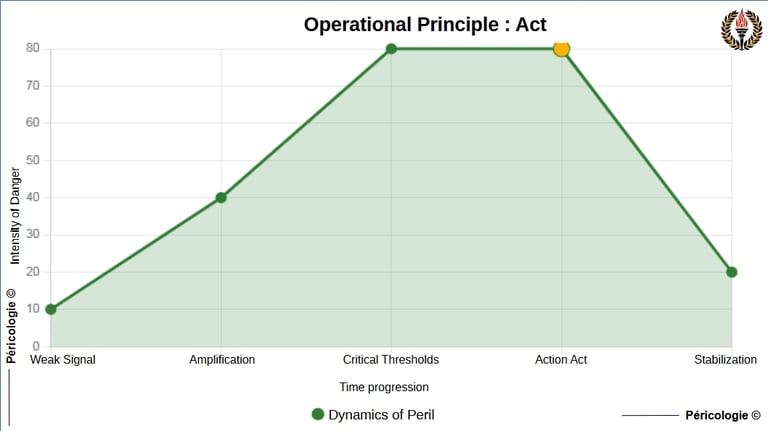

Act
Action diagram
Pericological Example
Context : In an interconnected factory, a weak signal (abnormal fluctuation in energy consumption) is detected by sensors, indicating a risk of overload that could lead to a systemic failure (tipping point). Observation (via the Observer) and analysis (via the Analyzer) reveal a positive loop dynamic amplifying the danger.
Pericological Application : Inspired by bio-inspired regulation (e.g.: redistribution of resources in an ant colony), the "Act" principle leads to immediate action : dynamically adjusting the distribution of the energy load via an automated algorithm, reducing the overload before it reaches the critical threshold .
Etymology
The term "agir" comes from the Latin agere , meaning "to do," "to act," or "to lead." This verb, formed from the Indo-European root ag- ("to lead," "to push"), implies a dynamic of intentional and directed movement.
Pericological Sources
The Methodology of Pericology
Pericological Methodology
The "Pericological Methodology" refers to the structured and systematic set of operational steps for anticipating, analyzing and preventing systemic perils in human, biological or technological contexts. Anchored in the three fundamental pillars of Pericology, observation, proactive prevention and contextual adaptation, it is broken down into three key phases : Explore, Analyze and Decode. These steps translate bio-inspired cooperative dynamics (from fauna and flora) into practical actions to detect warning signals, assess their severity and act before the perils reach a tipping point. Unlike reactive crisis management methodologies, it favors peripheral, methodical and contextual anticipation, without presupposing perfect cooperation, for systemic resilience.
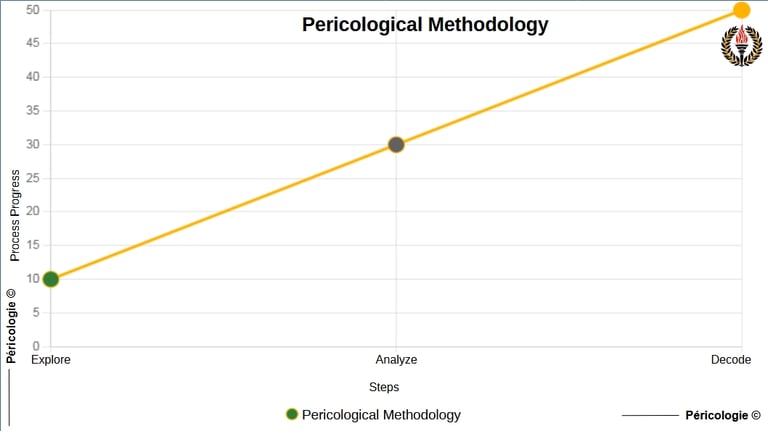

Pericological Methodology
Diagram of the pericological methodology
Pericological Example
Context : In an interconnected logistics network (e.g., industrial supply chain in 2025), a systemic peril emerges from increased dependence on vulnerable digital suppliers, amplified by weak signals such as network micro-interruptions (verified via global risk monitoring 2025). This context differs from classic crises (e.g., pandemic) by its initial invisibility, requiring non-ideological anticipation to preserve operational balance.
Periological Application : Explore : Monitor data flows to detect cyclical anomalies (inspired by ecosystem regulations, such as predator-prey cycles), identifying a 15% increase in network latencies as an early signal. Analyze : Assess the impact via an interdependency matrix (e.g., 40% of suppliers affected by a central hub), contrasting causes (software vulnerabilities) without external assumptions. Decode : Decode the critical threshold (e.g., latency > 200ms triggers a positive loop of cascading failures), proposing an action: decentralized redundancy via bio-inspired microgrids (like the interconnected roots of forests).
Etymology
Methodology : From the Greek methodos ("pursuit of a path", from meta : "towards" and hodos : "path") and logos ("discourse, study").
Pericological : From the Latin periculum ("danger, risk") and the Greek peri ("around").
Pericological Sources
Explore
In the context of Pericology, "Exploring" refers to the initial step of the methodology aimed at systematically and proactively studying the evolving dynamics of perils. This exploration consists of detecting early signals, whether weak or measurable, in interconnected systems (human, biological, technological) to identify potential causes, drivers and trajectories of dangers. Unlike simple passive observation, exploring involves active investigation, bio-inspired by the cooperative dynamics of nature, to map emerging, invisible or diffuse perils before they reach critical thresholds.
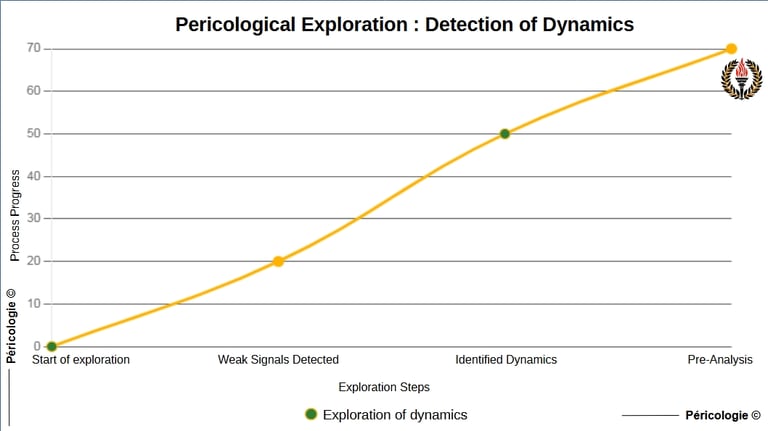

Explore
Explorer diagram
Pericological Example
Context : In an interconnected automated factory, irregular fluctuations in machine energy consumption are detected, but not yet critical. These weak signals could indicate an emerging systemic peril (e.g., cascading failure of the electrical grid). The context is marked by a complex interconnection between technological and human systems (operators monitoring machines), requiring proactive anticipation.
Pericological Application : The "Explore" stage consists of studying the evolutionary dynamics of this potential peril. Inspired by natural ecosystems (e.g., observing migratory flows in a school of fish to detect disturbances), the pericologist collects raw data via IoT sensors (energy consumption, frequency of breakdowns). He maps the interactions between machines and operators to identify warning signals (e.g., localized overheating).
Etymology
The term explorer comes from the Latin explorare , formed from ex- ("outside", "beyond") and plorare ("to shout" or "to examine", linked to the idea of sound or visual investigation). Historically, explorare referred to the act of reconnaissance of a territory or danger, often by military scouts.
Pericological Sources
Analyze
In Pericology, "Analyze" refers to the methodological step of assessing the importance, underlying causes and dynamics of identified hazards, in order to understand their potential for amplification or regulation. This analysis is based on a systemic approach, crossing weak signals, measurable signals and local contexts to anticipate critical thresholds (tipping points). Unlike a reactive analysis, it is proactive, bio-inspired (drawing on the cooperative dynamics of nature) and oriented towards immediate action to block hazards before they magnify.
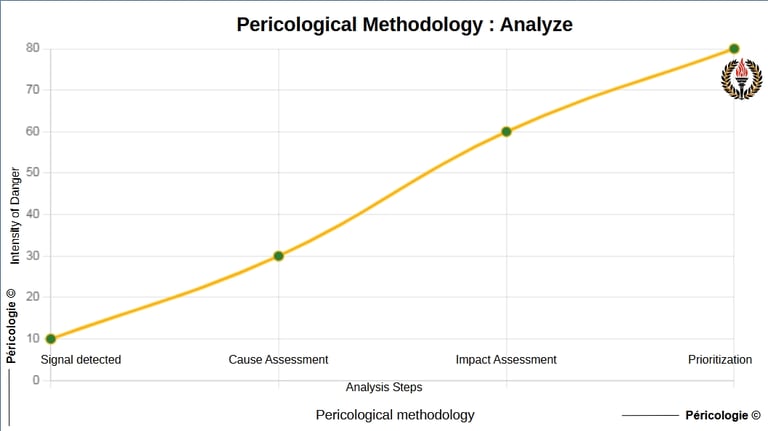

Analyze
Analysis diagram
Pericological Example
Context : In an interconnected logistics network (e.g., industrial supply chain), a weak signal is detected via "Explorer" : an abnormal fluctuation in delivery times due to latent geopolitical tensions, potentially amplified by technological dependencies (e.g., vulnerable tracking software). This systemic peril remains diffuse and invisible without analysis, risking a tipping point towards a global breakdown.
Pericological Application : Applying "Analyze" consists of evaluating the importance of this fluctuation (e.g.: potential impact on 40% of flows via a bio-inspired interdependency matrix, like trophic networks in ecology where a local disturbance cascades). We contrast the causes (geopolitical vs. technological) and measure the impact (e.g.: amplification via positive loop if ignored, leading to losses estimated at 15% of productivity).
Etymology
The term analyze comes from the Greek analusis (ἀνάλυσις), formed from ana- ("up", "through") and lusis ("dissolution", "separation"). It literally means "to break down into elements" or "to examine in detail".
Pericological Sources
Decode
In the context of Pericology, "Decoding" refers to the methodological step of interpreting and understanding the level of severity of hazards as well as their critical thresholds, based on weak, measurable or precursor signals identified during the exploration and analysis phases. This action aims to translate the complex dynamics of hazards (biological, socio-cultural, technological or systemic) into usable information to anticipate and prevent their transformation into crises. Decoding is not limited to passive analysis : it is an active, rigorous and contextual approach, which identifies potential tipping points and proposes hypotheses for evolution to guide immediate preventive actions.
Key characteristics : Role : Pivot between analysis (assessment of causes) and action (implementation of solutions), anchored in the methodological pillar. Objective : Transform raw data or signals into strategic understanding, promoting proactive prevention. Pericological specificity : Unlike simple data analysis (e.g.: classic risk management), decode integrates a bio-inspired and interdisciplinary vision, anticipating systemic dynamics.
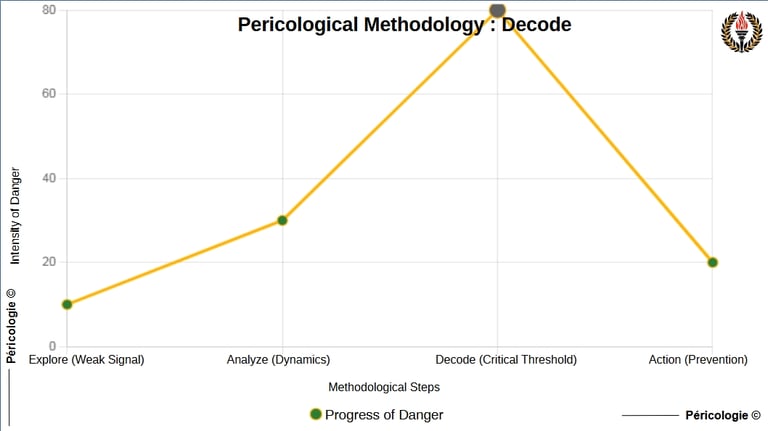

Decode
Decode diagram
Pericological Example
Context : In September 2025, an emerging systemic peril manifests itself through growing cyber threats, such as ransomware attacks targeting critical infrastructure (e.g., utilities, hospitals). Verified via the Canadian Centre for Cyber Security's 2025-2026 National Cyber Threat Assessment, which notes financial losses and operational disruptions, with cases such as the exploitation of MOVEit vulnerabilities in 2023 (extrapolated to 2025), cross-referenced with French reports on systemic risks in insurance (climate, cyber, pandemic). This peril is interconnected : a local attack can cascade into a global crisis, amplified by emerging states using commercial ecosystems for covert cyber operations.
Pericological Application : In an IT security team (human-technological context, aligned with Holopraxy ), after having explored the dynamics (e.g.: increase in intrusion attempts) and analyzed their impact (e.g.: vulnerabilities in file transfer systems), "Decode" evaluates the severity : critical threshold identified at 20% network overload (tipping point towards cascading failure, inspired by negative loops of ecosystem regulation such as redistribution in a coral reef).
Etymology
The term decode comes from the French dé- (a prefix indicating a reverse action or extraction) and coder (from the Latin codex , meaning "register" or "writing"). Originally, codex referred to a set of tablets or organized texts, implying a structure to be deciphered.
Pericological Sources
Key Concepts of Pericology
Key Pericological Concept
The "Key Concepts " designate the fundamental mechanisms that govern the dynamics of perils within Pericology, to anticipate and prevent systemic crises. These concepts, inspired by the cooperative dynamics of nature (fauna and flora), make it possible to model, understand and counter perils before they reach a critical threshold. They include the positive loop (self-reinforcing amplification of perils, e.g., viral propagation in an ecosystem or social panic), the negative loop (regulatory mechanisms stabilizing a system, e.g., body thermal regulation), and the tipping point. Anchored in scientific rigor, these concepts translate biological observations into practical tools for human, technological or systemic contexts, promoting peripheral anticipation.
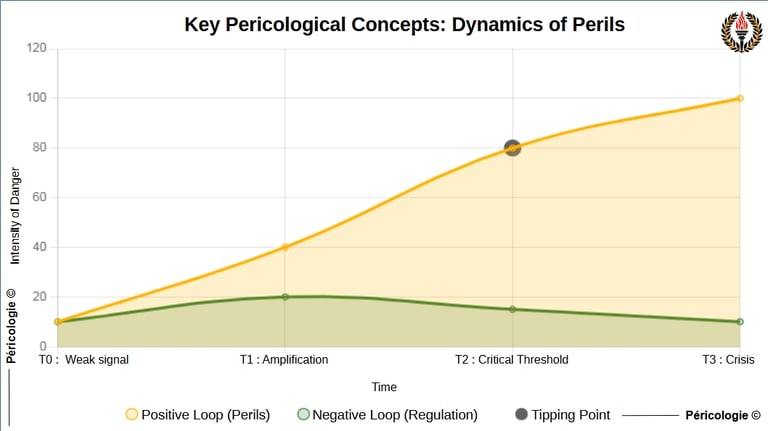

Key Pericological Concept
Diagram of the key pericological concept
Pericological Example
Context : In a coastal city, dune erosion due to frequent storms threatens local habitats and tourism infrastructure. Weak signals (e.g., decrease in stabilizing vegetation) are detected through pericological observation, but ignored by traditional coastal management approaches.
Pericological Application : Positive loop : Erosion accelerates sand loss, amplifying the vulnerability of dunes to storms (self-reinforcing). Negative loop : Inspired by ecosystems (e.g., plant roots fixing sand), Pericology suggests planting resistant plants to stabilize the dunes, regulating the danger. Tipping point : Identify the threshold where erosion becomes irreversible (e.g., 50% of dunes lost). Preventive action (planting before this threshold) blocks the crisis.
Etymology
The term " Key Concepts " comes from the Latin conceptus ("formed idea, thought") and the English key (from the Old English cǣg , "key"), meaning pivotal notions unlocking the understanding of complex dynamics.
Pericological : From the Latin periculum ("danger, risk") and the Greek peri ("around").
Pericological Sources
The Negative Pericological Loop
In Pericology, the "Pericological Negative Loop " refers to a systemic regulatory mechanism that mitigates or stabilizes a hazard before it reaches a critical threshold, drawing inspiration from the natural feedback dynamics observed in fauna and flora. This process counterbalances amplifying dynamics (positive loops) by mobilizing corrective actions based on the observation of weak or measurable signals. Unlike reactive approaches, the pericological negative loop acts proactively to prevent the escalation of biological, socio-cultural, technological or systemic hazards. It relies on collective coordination and self-management, adapted to local contexts, to maintain a systemic balance.
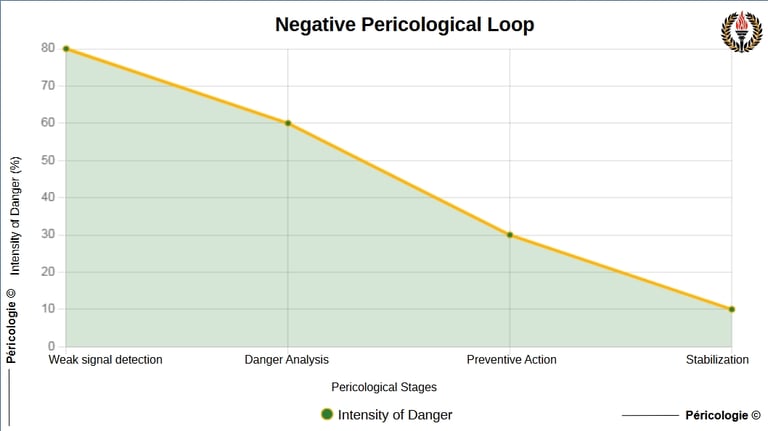

Negative Pericological Loop
Diagram of the Pericological Negative Loop
Pericological Example
Context : In a small farming community facing increasing soil erosion (emerging peril), farmers are observing declining yields (weak signal). Without intervention, this dynamic could reach a tipping point, rendering the land uncultivable.
Pericological Application : Pericologyapplies a negative loop inspired by forest ecosystems, where the plant cover stabilizes the soil. Farmers, through observation (pericologist as observer), identify the weak signal and analyze the cause (erosion by overgrazing). They act by planting plant hedges (preventive action), which reduce erosion and regulate the danger, preserving the balance of the agricultural system.
Etymology
Loop : From the old French " boucle " (12th century), from the Latin buccula ("small mouth" or "ring"), designating a closed cycle or feedback.
Negative : From the Latin negativus ("which denies" or "opposed"), indicating an action of attenuation or counterbalancing in the face of an amplifying dynamic.
Pericological : Derived from Pericology (Latin periculum , "danger", and Greek peri , "around"), emphasizing the peripheral anticipation of perils.
Pericological Sources
For enthusiasts
Our links
Message
© 2025. All rights reserved. By Pericology
